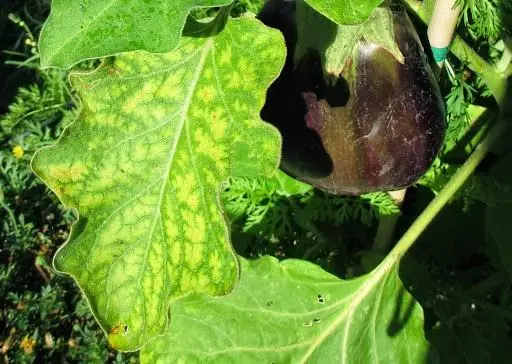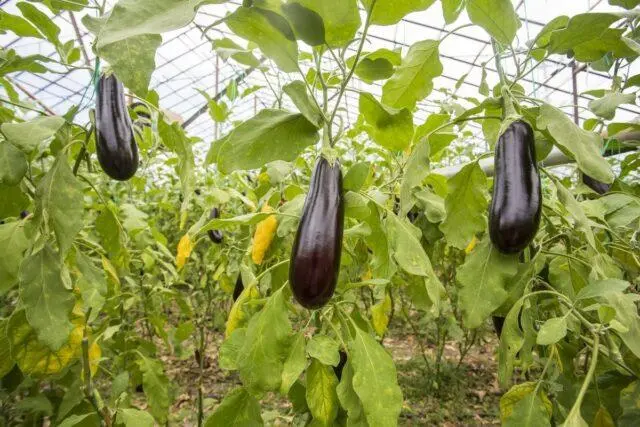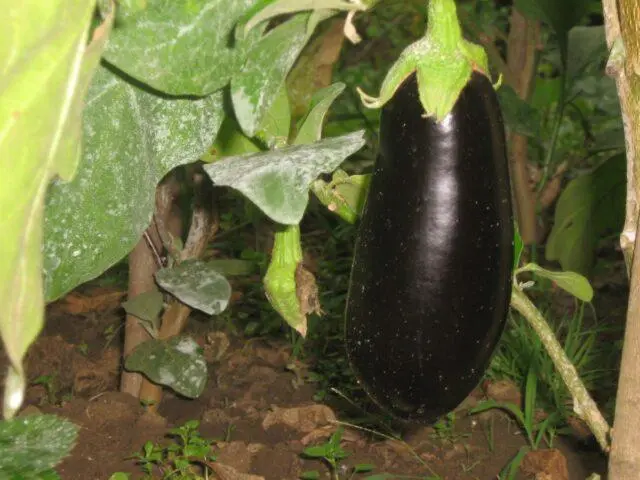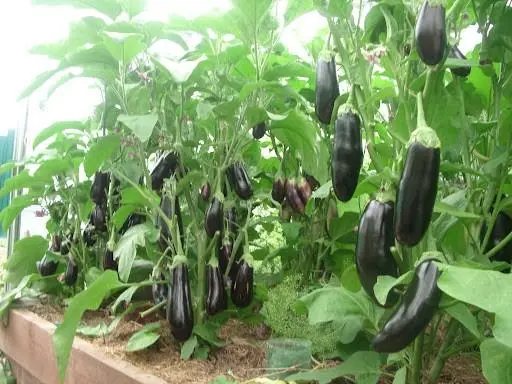Contents
Eggplant leaves turn yellow in the open field for various reasons, mainly due to care errors. Plants are quite demanding, they need a certain temperature regime, regular watering and top dressing. If you do not follow some rules, the foliage will turn yellow, the ovaries will begin to fall off, and the yield will decrease. To prevent this, it is recommended to follow the tips described in the article.
Why eggplant leaves turn yellow in the open field
Eggplant leaves turn yellow and wither for various reasons. In most cases, they are associated with improper care, violation of growing conditions. Although there may be objective factors. The main reasons are described below.
Unsuitable soil
Eggplants in the open field grow well on fertile and loose soils with a loose structure. Loamy soil with a neutral or slightly acidic reaction is optimally suited. If the soil, for example, is saline, contains a lot of clay and is infertile, this will definitely prevent plants from developing normally in open ground.
In such cases, eggplant leaves turn yellow and wither quite quickly, especially in combination with improper watering and strong shade. Therefore, it is necessary not only to carefully prepare the soil, but also to choose the right place in the open field.
Incorrect watering
Violation of the rules of watering often leads to the fact that eggplant leaves begin to turn yellow in open ground. The soil dries out rather quickly, especially in drought. Some gardeners give water plentifully, but irregularly, for example, once a week.
However, you need to water in medium volumes and stably, for example, 2-3 times a week, and sometimes more often. It is important to understand that excess water is also harmful. If, due to a lack, the leaves begin to turn yellow in the open field, then against the background of excessive moisture, the roots will rot. If this situation is repeated regularly, it will lead to the death of plants.
Lack or excess nutrition
Eggplants are very demanding on feeding, this is true when grown both in a greenhouse and in open ground. Plants need at least four times the application of fertilizers per season – at the seedling stage, after transplanting into the ground, during flowering and fruiting. First, the emphasis is on nitrogen supplements, then on superphosphate and potassium. Moreover, it is better to alternate mineral products with organic ones.

Eggplant leaves may turn yellow due to lack of fertilizer.
Determining nutrient deficiencies in open ground is quite simple. For example, a lack of nitrogen manifests itself in such signs:
- growth retardation;
- thin shoots;
- small stems;
- inflorescences of small sizes;
- few leaves.
If there is a lack of potassium, the symptoms are as follows:
- leaves are bluish-green, dull;
- a bronze tint is often observed;
- leaves of plants in open ground begin to turn yellow, then turn brown;
- they curl around the edges.
If there is not enough phosphorus, the signs are about the same as for nitrogen. Eggplants do not grow well even with good care in the open field, the leaves become dark green, with a bluish color. Some plants have purple foliage.
But if the lower leaves of eggplants turn yellow, this may also be due to an excess of fertilizers. The result is salinization of the soil, which is even worse than underfeeding. Therefore, you need to use the drugs clearly according to the instructions, without violating the dosage.
stress after transplant
Yellowing of eggplant leaves can also be associated with stress after transplanting into open ground. At this point, growing conditions change because the plants are not as comfortable in the garden as they are at home in a protected environment. Plus, the weather can get in the way. If at night the temperature drops below 12-15 degrees, this will have a bad effect on the development of plants.
So that the eggplant leaves do not begin to turn yellow in the open field, you should not rush to transplant. In most regions, the transfer of seedlings to a new place is planned for the second half of May. And if climatic conditions do not allow, it is better to grow in a greenhouse. This is true for Siberia, the Far East, and the northern regions.
The thickened landing
Eggplants should not be planted too close to each other both in the greenhouse and in the open field. Otherwise, it will lead to negative consequences:
- the leaves will turn yellow;
- the soil will become too wet, will not have time to dry;
- can rot the roots;
- infections will spread;
- fewer ovaries will form;
- plants develop worse due to lack of light.

Eggplants are planted at a distance of 35 cm from each other
Root damage
Damage to the roots can also cause the leaves to turn yellow. This occurs when transplanting plants in the open field, as well as at the picking stage. Sometimes they are so strong that the plants recover for a long time, the yield drops. To prevent this, it is necessary to water the pots and carefully move them to a new place, keeping the earthen clod. In order not to damage the roots, you should carefully loosen the soil, without going to a depth of more than 5 cm.
Temperature differences
Temperature fluctuations can cause eggplant leaves to turn yellow. This is especially common in outdoor cultivation, although in some regions problems may arise even with a greenhouse.
Eggplants develop normally if at night the temperature does not fall below +15, and during the day it does not rise above +30 °C. But it is not always possible to provide such conditions. A short-term drop in temperature will not affect the plants. And if the drops are repeated repeatedly, the leaves will turn yellow, in some cases the bushes can drop the ovary.
Diseases and pests
Eggplant leaves turn yellow and fall off also due to the influence of diseases. In open beds, plants often suffer from such pathogens:
- fusarium wilt;
- late blight;
- spotting;
- mosaic (viral disease);
- verticillosis.
Yellowing can also be associated with pests, for example, aphids, spider mites. You can detect them visually or by the presence of cobwebs on the back of the leaves. For prevention and treatment, folk remedies are used, as well as special preparations. When processing, the dosage in the instructions and safety rules must be observed, since many fungicides and insecticides are moderately toxic to humans.
Natural causes
Eggplant leaves turn yellow in spots and for natural reasons:
- At the seedling stage, when the cotyledon leaves begin to die, appearing first from the seed.
- In mature plants, when old green leaves die.
These are normal phenomena that are observed when grown in open beds and in a greenhouse. Therefore, no special measures are required.

Old leaves can be carefully cut off and sent to the compost pit.
What to do if eggplant leaves are yellow
If in the open field the tops begin to turn yellow, it is necessary to clarify the reason. To do this, carefully examine the plants and the soil under them. If it is too wet, watering is temporarily stopped. Normally, water should be given every 2-3 days, but if the weather is rainy, additional moisture is not needed. So that it does not evaporate, it is recommended to mulch with straw, sawdust and other materials.
Fertilizers for eggplant should also be applied in a timely manner. Even at the seedling stage, before picking, an infusion of mullein 1:10 or chicken manure 1:20 is added. If there is no organic matter, give ammonium nitrate 5 g per 10 l and potassium sulfate 20 g per 10 l.
So that the leaves do not turn yellow before transplanting into open ground, immediately after picking, they are fed with “Crystal” or other complex fertilizer. A few days before transplanting, a mixture of mineral fertilizers is added to the soil – superphosphate 50 g per 10 l, potassium sulfate 30 g and ammonium nitrate 5 g. Superphosphate with potassium sulfate is also given at the budding stage. During the formation of the ovaries, they are sprayed with a solution of boric acid 2 g per 10 liters.
If eggplant leaves turn yellow due to diseases and pests, it is necessary to treat the plants with special preparations. Insecticides are used to control insects:
- “Decis”;
- “Fufanon”;
- “Aktara”;
- “Agravertin”.
Fungicides are used to treat fungal infections:
- “Maksim”;
- “Order”;
- “Score”;
- “Fitoverm” and others.

During fruiting, plants are best treated with folk remedies.
Preventive measures
It is always easier to prevent developmental disorders than to deal with the consequences. To prevent the leaves from turning yellow when grown in open ground, experienced summer residents recommend following the following preventive measures:
- First of all, you need to carefully choose a place to land. It should be well lit and dry. The beds are located on a small hill, avoid stagnant rainwater.
- It is necessary to carefully prepare the soil in open ground. To make it fertile and light, on the eve of autumn it is dug up and compost or humus is added in the amount of 7-10 kg per 1 m2.
- In the process of growing plants, they are periodically inspected, if necessary, they are treated against pests and diseases.
- The beds are kept clean – they need to be periodically loosened, garbage removed.
- Do not plant seedlings too close to each other. The minimum allowable distance is 35 cm both in open areas and in the greenhouse. Then the leaves will grow normally, and will not fade.
Conclusion
Eggplant leaves turn yellow in open ground for various reasons, for example, due to insufficient watering, drought, irregular fertilization. Also, the reasons may be associated with insufficiently fertile soil. Therefore, when planting, you need to take into account all these points and ensure good care.









